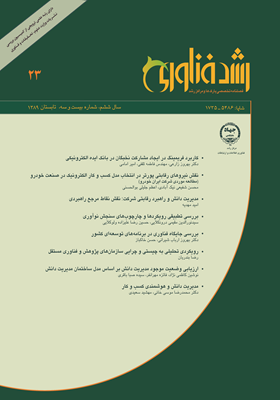مديريت دانش و راهبرد رقابتي شركت; نقش نقاط مرجع راهبردي
محورهای موضوعی : مديريت دانش
1 - -
کلید واژه: راهبرد رقابتي, مدیریت دانش, راهبرد مدیریت دانش, تئوري نقاط مرجع راهبردي,
چکیده مقاله :
شيوه تدوين و طراحي راهبرد كه در ده يا پنج سال قبل استفاده ميشد، ديگر كارايي نخواهد داشت. اين پديده تا حد زيادي به علت تغييراتي است كه در جهت افزايش اهميت اطلاعات و دانش به وجود آمده است. شركتها با تغيير جهت رقابت در بازار به سمت افزايش نرخ نوآوري دريافتند كه دانش، دارايي كليدي آنها است. دراكر به درستي خاطر نشان ساخت كه ارزشمندترين دارايي شركتها در قرن بيست و يكم، دانش و دانشگران آنها ميباشند. در چنين محيطي، توانايي شركت در بهرهگيري از داراييهاي ناملموس، بسيار مهمتر و حياتيتر از توانايياش در مديريت و سرمايهگذاري پيرامون داراييهاي ملموس و فيزيكي ميباشد. پيش فرض اصلي مديريت دانش اين است كه اقدامات آن موجب خلق نوعي مزيت رقابتي ميشود. اما اين موضوع چگونه تحقق مييابد؟ يك احتمال اين است كه شركتها نياز به نوعي راهبرد مديريت دانش دارند كه به تحقق اين هدف كمك كند. اما ماهيت راهبرد مديريت دانش چيست و چگونه در طي زمان تغيير ميكند؟ دو قطب اصلي مديريت دانش، فناوري و منابع انساني هستند. چه تركيبي از اين دو عامل ميتواند منجر به اثربخشي چنين راهبردهايي شود؟ اين وضعيت، مبهم و نامشخص است. زيرا مباني و چارچوب نظري مربوط به راهبرد مديريت دانش، نسبتاً جوان و نوپا بوده و طي چند سال اخير توسعه يافتهاند. در اين مقاله ابتدا به طور مختصر به راهبرد مديريت دانش پرداختهايم و سپس رابطه ميان راهبرد رقابتي و راهبرد مديريت دانش را با استفاده از مرور مباني نظري و تئوري نقاط مرجع راهبردي مورد بررسي قرار دادهايم.
The best way to achieve competence in global market is through planning and upgrading core competencies. Not only will the knowledge economy change the experience of workers, but organizations and countries must also rethink their economic strategies. How well an individual, an organization, an industry, a country does in acquiring and applying knowledge will become the key competitive factor. An organization with a good sense of KM has the potential to create significant value, but only if it is linked to its overall strategy and strategic decisions. Knowledge management (KM) is the latest strategy in increasing organizational competitiveness. The concept of treating organizational knowledge as a valuable strategic asset has recently become extremely common. KM efforts have been primarily focused on developing new applications of information technology, complemented to a lesser degree with implementing new organizational forms. The link between knowledge and business strategy has basically been overlooked. Thus KM has unfortunately developed into a matter of information technology primarily, followed by one of organizational behavior with business strategy generally not even considered. The purpose of present paper is to identify the relationship between KM and the firm's competitive advantage. In the first section the pertinent literature related to knowledge management and its impact on the competitive advantage of the firm was examined. Then the Porter's (1979) five forces model and Wernerfelt's (1984) Resource-based view of the firm were reviewed. In the next section the link between KM and strategy formulation by drawing on the resource-based view of the firm is addressed. In the last section the strategic reference points (SRPs) theory has been introduced and applied for classifying the KM strategies.


